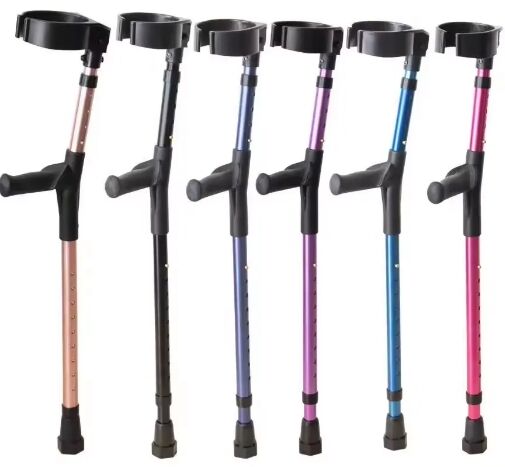قد يكون التكيف مع الحياة باستخدام العكازات تحت الإبط أمرًا مرهقًا في البداية. قد تلاحظ عدم الراحة في ذراعيك أو تكافح من أجل التوازن أثناء التحرك. هذه التحديات شائعة، لكنها لا يجب أن تعيقك. من خلال التركيز على التعديلات المناسبة وتعلم التقنيات الفعّالة، يمكنك تخفيف الضغط على جسمك. يمكن للتغييرات الصغيرة، مثل تحسين وضعيتك أو إضافة حشوة، أن تحدث فرقًا كبيرًا. ستجد أنه مع النهج الصحيح، يصبح التعامل مع الحياة اليومية أكثر قابلية للإدارة.
فهم أساسيات العكازات تحت الإبط
ما هي العكازات تحت الإبط؟
العكازات تحت الإبط، والتي تسمى أيضًا العكازات الإبطية، هي أدوات مساعدة على الحركة مصممة لمساعدتك على التحرك عندما يصبح المشي صعبًا أو مستحيلًا. تتميز هذه العكازات بجزء علوي مبطن يناسب أسفل ذراعيك ومقابض لمزيد من الدعم. إنها تسمح لك بنقل الوزن من ساقيك إلى الجزء العلوي من جسمك، مما يجعل من السهل البقاء متحركًا أثناء التعافي من إصابة أو جراحة. غالبًا ما تراها مصنوعة من مواد خفيفة الوزن مثل الألومنيوم أو الخشب، مما يضمن سهولة التعامل معها ومتانتها بما يكفي للاستخدام اليومي.
هذه العكازات قابلة للتعديل لتناسب طولك، مما يضمن وضعية الجسم المناسبة والراحة. عند استخدامها بشكل صحيح، يمكنها توفير الاستقرار والتوازن، مما يساعدك على استعادة الاستقلال أثناء التعافي. سواء كنت تعاني من إصابة قصيرة الأمد أو فترة تعافي أطول، فإن العكازات تحت الإبط توفر حلاً عمليًا.
متى يتم استخدامها؟
قد تحتاج إلى عكازات تحت الإبط إذا تعرضت لإصابة أو خضعت لعملية جراحية أو كنت تعاني من حالة تحد من قدرتك على تحمل الوزن على إحدى الساقين أو كلتيهما. وعادة ما يتم وصفها للكسور أو الالتواءات أو التعافي بعد الجراحة. غالبًا ما يوصي الأطباء باستخدامها للاستخدام قصير المدى، خاصة عندما تحتاج إلى دعم إضافي للشفاء بشكل صحيح.
كما أن هذه العكازات مفيدة أيضًا في مواجهة تحديات الحركة المؤقتة. على سبيل المثال، إذا التوى كاحلك أو أجريت جراحة في الركبة، فيمكنها مساعدتك في التحرك دون الضغط على المنطقة المصابة. وهي مثالية للمواقف التي تحتاج فيها إلى إبعاد الوزن عن الجزء السفلي من جسمك مع الحفاظ على مستوى معين من النشاط.
فوائد استخدام العكازات تحت الإبط
يأتي استخدام العكازات تحت الإبط بالعديد من الفوائد التي تجعل التكيف مع الحياة مع محدودية الحركة أسهل. أولاً، توفر دعمًا واستقرارًا ممتازين، مما يساعدك على الشعور بمزيد من الثقة أثناء الحركة. هذا مهم بشكل خاص عند التنقل على الأسطح غير المستوية أو الأماكن المزدحمة. ثانيًا، من السهل نسبيًا تعلم كيفية استخدامها، حتى لو لم تستخدم العكازات من قبل.
من بين المزايا الأخرى لهذه العكازات أنها ميسورة التكلفة ومتوفرة. يمكنك العثور عليها في معظم متاجر المستلزمات الطبية، وغالبًا ما تكون مغطاة بالتأمين. بالإضافة إلى ذلك، فهي خفيفة الوزن وقابلة للحمل، مما يجعلها ملائمة للاستخدام اليومي. مع التعديل والتقنية المناسبين، يمكن لهذه العكازات أن تقلل الضغط على جسمك وتساعدك على التعافي بشكل أكثر راحة.
"لا يجب أن يكون التكيف مع الحياة باستخدام العكازات تحت الإبط أمرًا صعبًا. باستخدام الأدوات والمعرفة المناسبة، يمكنك استعادة قدرتك على الحركة والثقة."
من خلال فهم أساسيات العكازات تحت الإبط، ستكون مستعدًا بشكل أفضل لاستخدامها بشكل فعال. فهي ليست مجرد أدوات للتنقل - بل هي خطوة نحو استعادة استقلاليتك.
الضبط والتركيب المناسب
كيفية ضبط العكازات على الارتفاع الصحيح
يعد الحصول على ارتفاع العكازات المناسب أمرًا ضروريًا للراحة والسلامة. ابدأ بالوقوف بشكل مستقيم مع ارتداء حذائك. ضع العكازات تحت ذراعيك واترك ذراعيك تتدلى بشكل طبيعي. يجب أن يكون الجزء العلوي من كل عكاز في وضع مستقيم. عن من 1.5 إلى 2 بوصة أسفل الإبطين. تمنع هذه الفجوة الصغيرة العكازات من الضغط مباشرة على الإبطين، مما قد يسبب عدم الراحة أو حتى الإصابة.
بعد ذلك، افحص مقابض اليد. يجب أن تتوافق مع ثنية معصمك عندما تكون ذراعيك مسترخيتين على جانبيك. يتيح لك هذا الوضع الحفاظ على ثنية طفيفة في مرفقيك أثناء الإمساك بالمقابض. إذا شعرت أن العكازات قصيرة جدًا أو طويلة جدًا، فاضبطها باستخدام زر الضغط أو آلية البراغي الموجودة عادةً على الجانبين. تجعل العكازات المضبوطة بشكل صحيح التحرك أسهل وتقلل من الضغط على جسمك.
ضمان الوضع المناسب للراحة والسلامة
يلعب وضع الجسم دورًا كبيرًا في مدى شعورك بالراحة والأمان أثناء استخدام العكازات. احرص دائمًا على إبقاء العكازات على مسافة 6 بوصات تقريبًا من جانبي قدميك عند الوقوف ساكنًا. تساعدك هذه المسافة على الحفاظ على التوازن وتمنع العكازات من التشابك مع ساقيك.
عند المشي، ركز على إبقاء وزنك على يديك، وليس تحت إبطيك. يمكن أن يؤدي الاعتماد بشدة على الأغطية المبطنة إلى وجع أو حتى تلف الأعصاب بمرور الوقت. بدلاً من ذلك، استخدم ذراعيك لدعم جسمك أثناء الحركة. حافظ على ظهرك مستقيمًا وكتفيك مسترخيتين لتجنب التوتر غير الضروري. لا تعمل الوضعية الجيدة على تحسين الراحة فحسب، بل تساعدك أيضًا على البقاء مستقرًا أثناء التنقل على أسطح مختلفة.
الأخطاء الشائعة التي يجب تجنبها أثناء التعديل
تجنب الأخطاء الشائعة قد ينقذك من الألم أو الإحباط غير الضروريين. أحد الأخطاء الشائعة هو وضع العكازات عالية جدًا أو منخفضة جدًا. العكازات الطويلة جدًا تجبرك على الانحناء، بينما العكازات القصيرة جدًا تجعلك تميل بشكل غير مريح. يمكن أن يؤدي كلا السيناريوهين إلى وضعية سيئة وعدم الراحة.
هناك خطأ آخر وهو الإمساك بالمقابض بإحكام شديد. فمع مرور الوقت، قد يتسبب هذا في إجهاد اليد أو ظهور بثور. ولمنع حدوث ذلك، فكر في استخدام مقابض مريحة أو إضافة حشوة للمقابض. ولا تنس أيضًا فحص الأطراف المطاطية الموجودة في أسفل العكازات. فقد تتسبب الأطراف المهترئة في انزلاق العكازات، مما يزيد من خطر السقوط.
أخيرًا، لا تتخطَّ عملية التعديل تمامًا. فاستخدام العكازات مباشرة من العلبة دون تخصيصها وفقًا لطولك واحتياجاتك قد يؤدي إلى عدم ملاءمتها بشكل جيد. إن تخصيص بضع دقائق لضبطها بشكل صحيح يضمن لك تجربة أكثر سلاسة مع استمرارك في التكيف مع الحياة باستخدام العكازات تحت الإبط.
تقنيات الاستخدام المريح
نصائح لتجنب آلام الإبط
يعد ألم الإبط من أكثر الشكاوى شيوعًا عند استخدام العكازات تحت الإبط. لتجنب هذا الانزعاج، ركز على الوضع الصحيح. تأكد من أن الجزء العلوي من العكازات يقع على مسافة 1.5 إلى 2 بوصة أسفل الإبطين. تمنع هذه الفجوة الصغيرة العكازات من الضغط مباشرة على المناطق الحساسة. حافظ دائمًا على وزنك على يديك بدلاً من الاعتماد على الجزء العلوي المبطن. تقلل هذه العادة الضغط على الإبطين وتقلل من الألم.
يمكن أن يساعد أيضًا إضافة حشوة إضافية إلى الجزء العلوي من العكاز. يمكنك استخدام وسائد العكاز التي يتم شراؤها من المتجر أو لف منشفة ناعمة حول الجزء العلوي لإصلاح سريع. إذا لاحظت احمرارًا أو تهيجًا، خذ فترات راحة لإراحة ذراعيك. يمكن أن يمنح التبديل بين الوقوف والجلوس جسمك وقتًا للتعافي. إن الاهتمام بهذه التفاصيل يجعل التكيف مع الحياة مع العكازات أكثر راحة.
توزيع الوزن بشكل صحيح عند استخدام العكازات
إن توزيع وزنك بشكل صحيح هو مفتاح تجنب الإجهاد والحفاظ على التوازن. ضع يديك دائمًا بثبات على المقابض واترك ذراعيك تقومان بالعمل. تجنب الاعتماد بشدة على الإبطين، حيث يمكن أن يؤدي هذا إلى الألم أو حتى تلف الأعصاب. حافظ على ثني مرفقيك قليلاً أثناء الإمساك بالمقابض. يسمح لك هذا الوضع بالحفاظ على السيطرة ويقلل من التعب.
عند الوقوف بثبات، ضع العكازات على مسافة 6 بوصات تقريبًا من قدميك. تساعدك هذه المسافة على البقاء ثابتًا وتمنع العكازات من الانزلاق. أثناء الحركة، ركز على تحويل وزنك بسلاسة بين يديك وساقك غير المصابة. إن ممارسة هذه التقنية ستجعل المشي يبدو أكثر طبيعية وأقل إرهاقًا.
تقنيات المشي لتحقيق الاستقرار والكفاءة
قد يبدو المشي باستخدام العكازات محرجًا في البداية، لكن استخدام التقنيات الصحيحة يمكن أن يحسن من استقرارك وكفاءتك. ابدأ بوضع العكازتين أمامك قليلاً، حوالي 12 إلى 18 بوصة. حرك ساقك المصابة للأمام، مع إبقائها بعيدة عن الأرض. ثم استخدم ذراعيك لدفع نفسك للأمام، مع وضع ساقك غير المصابة خلف العكازات. كرر هذا النمط للحفاظ على إيقاع ثابت.
لمزيد من الثبات، حافظ على ظهرك مستقيمًا ونظرك للأمام. فالنظر إلى الأسفل كثيرًا قد يؤدي إلى اختلال توازنك. إذا كنت تصعد السلالم، فتذكر أن تصعد بساقك السليمة أولاً ثم تنزل بساقك المصابة. إن ممارسة هذه الخطوات بانتظام ستساعدك على اكتساب الثقة وتجعل التكيف مع الحياة باستخدام العكازات أسهل.
"إن إتقان أساسيات استخدام العكازات يمكن أن يغير تجربة التعافي الخاصة بك. باستخدام التقنيات الصحيحة، ستتحرك بسهولة أكبر وبأقل قدر من الانزعاج."
تعزيز الراحة
إضافة الحشو إلى العكازات
إن إضافة حشوة إلى عكازاتك يمكن أن يحدث فرقًا كبيرًا في راحتك. غالبًا ما تكون الحشوة القياسية للعكازات صلبة وغير مريحة، خاصة بعد الاستخدام لفترة طويلة. يمكنك حل هذه المشكلة باستخدام وسادات عكاز متخصصة مصنوعة من الرغوة الناعمة أو الجل. تناسب هذه الوسادات قمم عكازاتك بشكل مريح وتوفر توسيدًا إضافيًا لإبطيك. إذا لم يكن لديك إمكانية الوصول إلى الوسادات التي يتم شراؤها من المتجر، فإن لف منشفة أو قطعة قماش ناعمة حول قمم العكاز يعمل كبديل سريع.
انتبه إلى ملمس الحشوة بعد إضافتها. يجب أن تقلل من الضغط على الإبطين دون أن تجعل العكازات غير مستقرة. افحص الحشوة بانتظام بحثًا عن أي تآكل أو تلف. يضمن استبدالها عندما تصبح رقيقة أو مهترئة الحفاظ على الراحة المستمرة. يمكن أن تجعل التعديلات الصغيرة مثل هذه التكيف مع الحياة مع العكازات أسهل كثيرًا.
استخدام المقابض المريحة لدعم اليد بشكل أفضل
إن يديك تقومان بمعظم العمل عندما تستخدم العكازات، لذا فإن دعم اليد بشكل صحيح أمر ضروري. يمكن أن تسبب مقابض العكازات القياسية عدم الراحة أو حتى ظهور بثور بمرور الوقت. يمكن أن يساعدك التحول إلى مقابض مريحة. تم تصميم هذه المقابض لتناسب الشكل الطبيعي ليديك، مما يقلل من الإجهاد ويحسن تجربتك بشكل عام.
إن تركيب المقابض المريحة أمر بسيط. حيث تنزلق معظم المقابض على مقابض العكاز أو يتم ربطها بأشرطة فيلكرو. وبمجرد تثبيتها، توفر قبضة أكثر أمانًا وراحة. وستلاحظ تعبًا أقل في يديك ومعصميك، خاصة أثناء فترات الاستخدام الطويلة. إذا كنت تبحث عن طريقة ميسورة التكلفة لتحسين عكازاتك، فإن المقابض المريحة هي خيار رائع.
إكسسوارات لتحسين القدرة على الحركة وتقليل الضغط
يمكن أن ترفع الملحقات من تجربة العكاز إلى المستوى التالي. تساعد الأطراف المطاطية ذات قوة الجر الأفضل في منع الانزلاق، وخاصة على الأسطح المبللة أو غير المستوية. يمكنك أيضًا العثور على أطراف تمتص الصدمات مما يقلل من التأثير على ذراعيك وكتفيك مع كل خطوة. تجعل هذه الترقيات الصغيرة التحرك أكثر أمانًا وأقل إرهاقًا.
فكر في إضافة حقيبة أو جراب لحمل الضروريات مثل هاتفك أو محفظتك أو زجاجة المياه. هذا يحافظ على يديك حرة ويجعل المهام اليومية أكثر قابلية للإدارة. بالنسبة لأولئك الذين يتعاملون مع الاستخدام طويل الأمد، يمكن أن توفر أصفاد الساعد أو الأشرطة ثباتًا إضافيًا وتقلل من الجهد اللازم لحمل العكازات. لا تعمل هذه الملحقات على تحسين الحركة فحسب، بل تجعل أيضًا التكيف مع الحياة مع العكازات أكثر ملاءمة وأقل إجهادًا.
"الراحة ليست مجرد رفاهية عند استخدام العكازات، بل هي ضرورة. يمكن للتغييرات البسيطة مثل إضافة الحشو، أو ترقية المقابض، أو استخدام ملحقات مفيدة أن تحول تجربتك."
بدائل للعكازات تحت الإبط
نظرة عامة على عكازات الساعد
توفر عكازات الساعد، المعروفة أيضًا بعكازات الكوع، بديلاً أنيقًا وعمليًا للعكازات التي توضع تحت الإبط. تتميز هذه العكازات بكفة تلتف حول الساعد ومقبض يد للدعم. وعلى عكس عكازات الإبط، فهي لا تضغط على الإبطين، مما قد يجعلها أكثر راحة للاستخدام على المدى الطويل.
قد تجد أن عكازات الساعد أسهل في المناورة، وخاصة في الأماكن الضيقة. فهي تسمح بحركة مشي أكثر طبيعية وتمنحك سيطرة أفضل على تحركاتك. إذا كنت تتعامل مع إصابة أو حالة طويلة الأمد، فإن هذه العكازات يمكن أن تقلل الضغط على الجزء العلوي من جسمك. بالإضافة إلى ذلك، فإن تصميمها خفيف الوزن يجعلها سهلة الحمل والتخزين عند عدم استخدامها.
تعمل عكازات الساعد بشكل أفضل إذا كان لديك قوة وتوازن جيدين في الجزء العلوي من الجسم. فهي تتطلب منك الاعتماد بشكل أكبر على ذراعيك ويديك للحصول على الدعم. إذا كنت تبحث عن وسيلة مساعدة على الحركة تبدو أقل حجمًا وأكثر تنوعًا، فقد تكون عكازات الساعد مناسبة تمامًا.
فوائد سكوتر الركبة
توفر سكوترات الركبة أو مشايات الركبة حلاً عصريًا ومريحًا للتنقل. تأتي هذه الأجهزة مع منصة مبطنة حيث يمكنك إراحة ساقك المصابة بينما تستخدم ساقك الأخرى لدفع نفسك للأمام. كما أنها تتضمن مقودًا للتوجيه ومكابح لمزيد من الأمان.
من أهم مميزات سكوتر الركبة هو الراحة التي توفرها. فلا داعي للقلق بشأن آلام الذراع أو الإبط لأن وزنك يرتكز على السكوتر بدلاً من الجزء العلوي من الجسم. وهي مفيدة بشكل خاص للأشخاص الذين يتعافون من إصابات في القدم أو الكاحل. يمكنك التحرك بسلاسة دون الضغط على ساقك المصابة.
تعمل سكوترات الركبة بشكل جيد في الأماكن المغلقة والمفتوحة، وذلك بفضل عجلاتها القوية. فهي أسرع من العكازات وتتطلب جهدًا أقل لاستخدامها. إذا كنت بحاجة إلى قطع مسافات أطول أو تريد خيارًا أكثر استقرارًا، فقد تكون سكوترات الركبة هي الخيار الأمثل. فقط تأكد من وجود مساحة كافية للتنقل، حيث قد يكون من الصعب استخدامها في المناطق المزدحمة أو الضيقة.
أجهزة التنقل التي تعمل بدون استخدام اليدين كخيار
ترفع أجهزة الحركة التي تعمل بدون استخدام اليدين الابتكار إلى المستوى التالي. يتم ربط هذه الأجهزة بالساق المصابة، مما يسمح لك بالمشي دون استخدام يديك أو ذراعيك للدعم. تعمل هذه الأجهزة عن طريق نقل وزنك إلى فخذك العلوي، مع الحفاظ على ساقك السفلية مرتفعة ومحمية.
الميزة الرئيسية للأجهزة التي تعمل بدون استخدام اليدين هي الحرية التي توفرها. يمكنك استخدام يديك للمهام اليومية مثل حمل البقالة أو فتح الأبواب مع البقاء متحركًا. إنها مثالية للأفراد النشطين الذين يريدون الحفاظ على استقلاليتهم أثناء التعافي.
تتطلب هذه الأجهزة بعض التدريب لإتقانها، ولكن بمجرد أن تتقنها، ستشعر أنها سهلة الاستخدام. فهي خفيفة الوزن وقابلة للتعديل ومصممة لتناسب بشكل آمن. إذا كنت تبحث عن بديل عالي التقنية للعكازات التقليدية، فإن أجهزة التنقل بدون استخدام اليدين تقدم حلاً فريدًا وعمليًا.
"إن استكشاف البدائل للعكازات تحت الإبط قد يفتح آفاقًا جديدة للراحة والقدرة على الحركة. سواء اخترت عكازات الساعد أو سكوتر الركبة أو جهازًا بدون استخدام اليدين، فإن الخيار الصحيح يمكن أن يجعل رحلة التعافي أكثر سلاسة ومتعة."
من خلال التركيز على التعديلات المناسبة وإتقان تقنيات الاستخدام وتعزيز الراحة، يمكنك جعل تعافيك أكثر سلاسة. استكشف البدائل مثل عكازات الساعد أو سكوتر الركبة إذا كانت العكازات التقليدية لا تلبي احتياجاتك. ضع سلامتك وراحتك دائمًا في المقام الأول. للحصول على إرشادات شخصية، استشر أخصائي رعاية صحية يمكنه تقديم المشورة وفقًا لحالتك.

 EN
EN









































